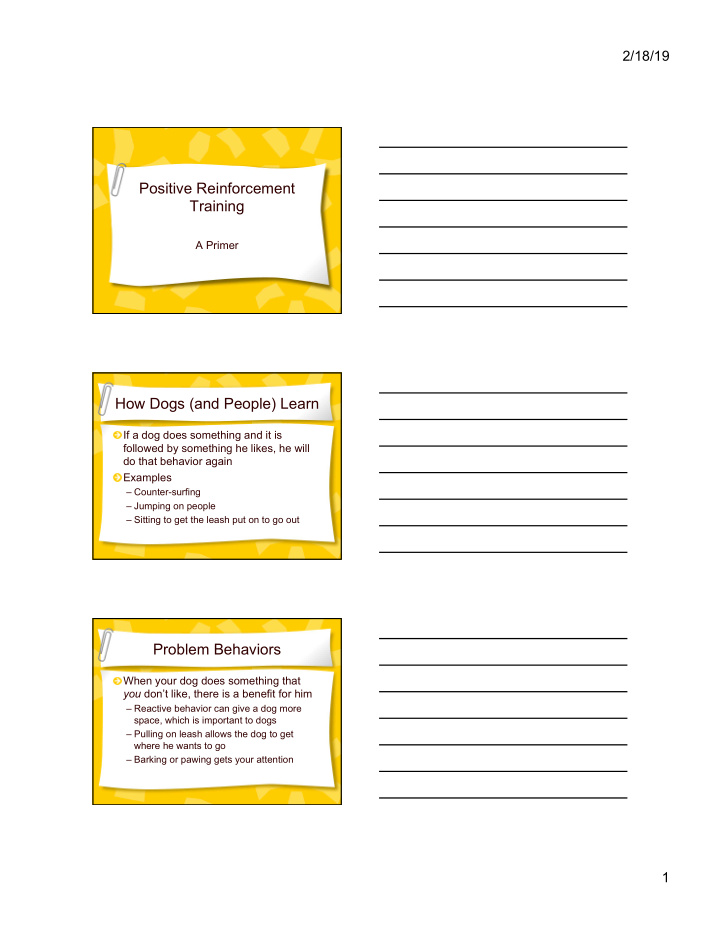



2/18/19 Positive Reinforcement Training A Primer How Dogs (and People) Learn If a dog does something and it is followed by something he likes, he will do that behavior again Examples – Counter-surfing – Jumping on people – Sitting to get the leash put on to go out Problem Behaviors When your dog does something that you don’t like, there is a benefit for him – Reactive behavior can give a dog more space, which is important to dogs – Pulling on leash allows the dog to get where he wants to go – Barking or pawing gets your attention 1
2/18/19 Problem Behaviors The dog isn’t following a moral right/ wrong code, but rather doing what feels right at the time It’s not about love! The dogs aren’t doing these things to hurt or annoy you. They’re just acting like dogs. Why Do They Act This Way? Behavior is a combined result of genetics and environment – Breed tendencies – Socialization – Previous experiences Learning Theory Classical Conditioning – Ivan Pavlov’s Bell – Emotional State – Involuntary Behavior (drooling, panting, piloerection) Operant Conditioning – B.F. Skinner/Rats pushing levers – Voluntary Behavior (sit, down, come, shake) Both are usually working together! 2
2/18/19 Classical Conditioning Operant Conditioning Learning Theory We will use both classical and operant conditioning to train the dogs We want them to feel safe, comfortable, and happy in the room = classical conditioning We want them to learn that behaviors we like are followed by things they like = operant conditioning 3
2/18/19 Things Dogs Like Let ’ s talk about some things your dogs like . . . We are going to add another tool to the list: the clicker Click & Treat The clicker makes a noise that has no inherent meaning for the dog We’ll pair it with food, and the dog will learn that the click indicates when we will be giving a treat This speeds up the dog’s ability to learn because we can mark the exact behavior that we like Click & Treat Marine mammal shows and zoo keepers use the same training techniques (but they use a whistle) By marking and rewarding specific behaviors, we can teach the dog to do all sorts of things – Including “ abnormal ” behaviors, like stay and loose-leash walking 4
2/18/19 Let’s Practice How to hold the clicker Practice clicking for good timing Train a human Train each other Training Game Train a person to do a simple behavior using the clicker (no words!) More feedback is better than less Watch for stress behaviors – People: talking, clasping hands, fidgeting – Dogs: barking, pulling, paying more attention to the environment than to the owner Demos Luring – Using a treat to guide the dog to move into the behavior you desire Capturing – Waiting for the dog to do the behavior you desire Shaping – Rewarding increments of success toward the behavior you want 5
2/18/19 Key Take Aways Training is a mechanical skill Training is all about – Setting criteria – Reinforcing the right thing at the right time Questions? 6
Recommend
More recommend